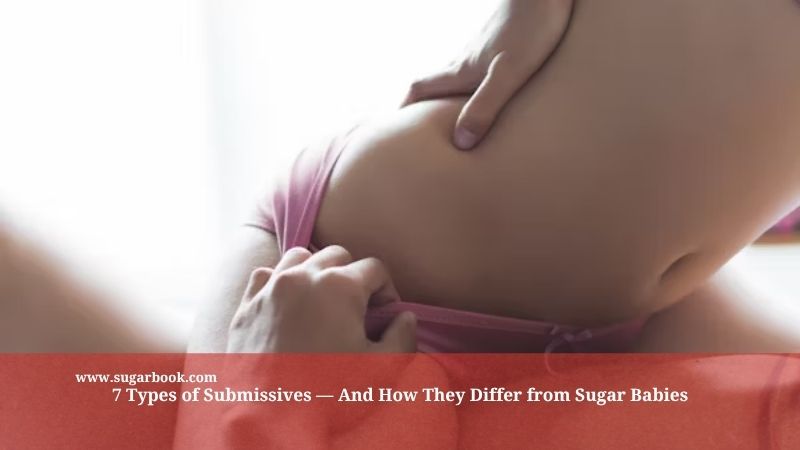
Meet successful sugar daddies and confident sugar babies on the world’s leading sugar dating app. Join free today.
📌 Editor’s Note (2025 Update): We’ve expanded this article with a deeper look at 7 types of submissives – and how they differ from sugar babies in modern dating.
When diving into the world of kink and power dynamics, one question keeps coming up: What are the different types of submissive personalities? And more importantly — how are they different from sugar babies in modern sugar dating?
As more people explore nontraditional relationships through platforms like Sugarbook, understanding the types of submissive identities becomes essential for forming healthy, consensual, and aligned connections.
This article will explain the 7 most recognized types of submissive roles, how they function in D/s (Dominant/submissive) dynamics, and how they compare to the sugar baby experience.
Let’s break it down.
Contents
- Different Submissive Archetypes: 7 Types of Submissive Explained
- Not All Subs Are the Same: Personality and Power Dynamics
- Sugar Baby vs Submissive: Understanding the Core Differences
- Understanding Your Identity in Sugar Culture
- Frequently Asked Questions About Types of Submissive
- Conclusion: Empowerment Through Self-Knowledge and Consent
- 7 Submissive Types
Different Submissive Archetypes: 7 Types of Submissive Explained
1. Service Submissive
A service submissive gains fulfillment through acts of service. These individuals enjoy being useful — not just sexually, but emotionally or domestically. They may cook, clean, organize, or offer personal assistance under their dominant’s direction.
Key Traits:
-
Task-oriented
-
Respectful of structure
-
Finds joy in obedience and usefulness
They’re often mistaken for sugar babies due to their caretaking role, but their motive is devotion, not exchange.
2. Brat Submissive
This type of submissive challenges authority playfully. A brat isn’t disrespectful — they enjoy teasing, resisting, or testing limits, knowing their dominant will maintain control.
Key Traits:
-
Flirtatious and cheeky
-
Seeks boundaries, not chaos
-
Enjoys playful correction
Unlike sugar babies, who may negotiate benefits openly, brats use behavior to invite control rather than request resources.
3. Slave Submissive
A slave submissive seeks total power exchange (TPE). They may relinquish decisions, lifestyle control, or full emotional dependence to a trusted dominant.
Key Traits:
-
Absolute obedience
-
Deep trust in their partner
-
Often includes contracts or 24/7 dynamics
This dynamic is often confused with unhealthy control. However, when consensual, it’s one of the most structured and secure types of submissive relationships.
4. Little or Ageplay Submissive
Ageplay submissives, often called “littles,” roleplay as younger versions of themselves — not to be confused with underage or illegal behavior.
Key Traits:
-
Craves nurturing and structure
-
May use stuffed animals, pacifiers, or cute clothing
-
Partner (the “Daddy” or “Mommy”) offers guidance and affection
While sugar babies can exhibit similar softness, the psychological framework of ageplay is more complex and often rooted in care-based kink.
5. Primal Prey Submissive
Primal prey submissives tap into instinctual submission. They enjoy roughness, physical control, and being “hunted” emotionally or physically by a dominant.
Key Traits:
-
Responsive to nonverbal dominance
-
Enjoys high-intensity play or passion
-
Often paired with primal “hunter” dominants
This archetype is based on instinct rather than structure, setting it apart from sugar dating’s often curated experience.
6. Pleasure Submissive
These submissives enjoy giving pleasure and receiving it under direction. They may surrender control in the bedroom but still function independently outside of kink scenes.
Key Traits:
-
Sensual and responsive
-
Enjoys being trained or explored
-
May appear dominant in daily life
They’re the most compatible with sugar babies, as their dynamic often involves pleasure-for-guidance arrangements — though the intentions differ.
7. Submissive Switch
Some people identify as switches, meaning they can move between dominant and submissive roles depending on mood, partner, or dynamic.
Key Traits:
-
Emotionally adaptable
-
Curious about power dynamics
-
Seeks balance, not labels
A submissive switch may lean submissive in one relationship and dominant in another — making them ideal for sugar daters exploring kink without hard limits.
Not All Subs Are the Same: Personality and Power Dynamics
Understanding the types of submissive roles means recognizing that not every sub fits into the same box. Just as sugar babies come from diverse backgrounds with different goals, submissives have unique motivations and desires that shape their experiences.
Emotional Needs and Roleplay Boundaries
Each type of submissive has different emotional needs. A service sub may need recognition and purpose, while a little might crave safety and affection. Brats, on the other hand, often seek consistency through playful correction.
Knowing your needs — and your limits — is vital in identifying the right dynamic.
Boundaries vary significantly among submissive types:
-
Some prefer structure with strict obedience.
-
Others enjoy flexibility with emotional give-and-take.
-
Some are sexual; others are entirely non-sexual.
These nuances separate submissive identities from sugar babies, who typically focus more on lifestyle alignment and mutual benefit than psychological roleplay.
The Importance of Communication and Consent
Whether exploring primal play, age dynamics, or power exchange, every type of submissive relationship must prioritize:
-
Ongoing consent
-
Check-ins and safe words
-
Clear role definitions
-
Open conversations about expectations
While sugar dating often begins with agreements around lifestyle and support, D/s dynamics depend on continuous negotiation and trust.
Flexibility in D/s Role Exploration
Some people find they shift between different types of submissive over time. For example, a brat may evolve into a pleasure sub or a switch. There’s no fixed identity — and that’s okay.
Being open to growth helps both sugar daters and submissives discover authentic, compatible relationships that reflect where they are emotionally and mentally.
Sugar Baby vs Submissive: Understanding the Core Differences
It’s common to see sugar babies labeled as submissive — and vice versa. While some overlap exists, these identities stem from different foundations.
Power Balance and Relationship Control
In a sugar dating dynamic:
-
Both parties usually retain independence.
-
Terms are often negotiated mutually.
-
Power is shared, or held by the wealthier partner in agreed ways.
In a submissive dynamic:
-
One party often yields control intentionally.
-
Emotional or psychological power plays a larger role.
-
Leadership and obedience are more emphasized than lifestyle exchange.
The sugar baby isn’t always submissive. Many are assertive, know what they want, and negotiate with clarity.
Financial vs Psychological Dynamics
Sugar dating primarily revolves around lifestyle elevation and mutual value — whether through financial support, mentorship, or exclusivity.
In contrast, submissive dynamics often focus on:
-
Power surrender
-
Emotional control
-
Role-based behavior
Not all submissives seek financial gain, and not all sugar babies crave psychological surrender.
When Sugar Dating Overlaps with Submissive Roles
Some sugar babies naturally express submissive traits — such as obedience, service, or softness — especially with alpha sugar daddies or sugar mamas.
This can lead to hybrid dynamics, where the relationship is both sugar-based and kink-informed.
The key is open discussion. If kink enters the mix, both parties should treat it with the same clarity and consent as traditional sugar dating agreements.
Understanding Your Identity in Sugar Culture
Can Sugar Babies Be Submissive?
Yes, absolutely. Many sugar babies enjoy being led, pampered, or given direction. However, the difference lies in why they engage in that dynamic.
Submissives seek control-based fulfillment, while sugar babies may enjoy support, mentorship, or lifestyle benefits without giving up power.
Knowing where you fall on the spectrum can help you:
-
Set relationship boundaries
-
Match with compatible partners
-
Avoid misunderstandings
Exploring Your Role Safely on Sugarbook
Sugarbook allows users to express their personality, desires, and preferences clearly in their profiles. This transparency supports those exploring:
-
Dominant/submissive dynamics
-
Mentorship roles
-
Emotional support preferences
By aligning with like-minded users, you can safely explore your types of submissive interests while maintaining autonomy.
Aligning Kink and Lifestyle Preferences
You don’t have to choose between being a sugar baby and a submissive. Many relationships today are hybrids – combining lifestyle perks with psychological roleplay.
Here’s how to integrate both worlds:
-
Define whether you’re more kink-motivated or lifestyle-driven.
-
Discuss expectations before intimacy.
-
Use Sugarbook to find mature, experienced partners open to deeper exploration.
Frequently Asked Questions About Types of Submissive
What are the most common types of submissive personalities?
Service subs, brats, and pleasure subs are the most commonly explored. However, each person may embody traits from multiple submissive types depending on the dynamic and partner involved.
Do all submissives enjoy domination?
Not necessarily. Some submissives enjoy structure or service, while others prefer nurturing or emotional control. Domination varies widely – it isn’t always aggressive or overt.
Can someone be submissive and independent?
Absolutely. Many submissives are high-achieving, independent individuals who enjoy choosing when and how to submit. Submission is about control given — not taken.
How do submissive types affect sugar dating dynamics?
Some sugar babies may align with submissive identities, but sugar dating doesn’t require power exchange. When combined thoughtfully, the roles can create deeply fulfilling arrangements based on both value and kink.
What if I’m still unsure of my role?
That’s totally normal. Many people experiment before settling into a dynamic that feels right. Use Sugarbook’s community and features to explore safely, without pressure.
Does Sugarbook support kink-aligned sugar relationships?
While Sugarbook isn’t a kink site, it welcomes users who define their ideal relationships through:
-
Power dynamics
-
Lifestyle alignment
-
Emotional structure
You can explore submissive identities while still enjoying the sugar dating culture.
Conclusion: Empowerment Through Self-Knowledge and Consent
Understanding the types of submissive identities opens doors to deeper, more authentic relationships — in and beyond the sugar dating world. Whether you’re a service sub, a brat, or a submissive switch, your role is valid, beautiful, and worthy of exploration.
If you’re on Sugarbook, embracing your submissive tendencies doesn’t mean giving up independence — it means owning your desires and shaping your ideal dynamic.
Whether you’re a sugar baby, a submissive, or somewhere in between, clarity and consent are your greatest assets.
Because in both kink and sugar culture, power is only meaningful when it’s freely and joyfully given.
FAQ
Q1: Are submissives the same as sugar babies?
A1. No. Submissives focus on emotional or power surrender. Sugar babies may enjoy care, but the dynamic is more lifestyle- or benefit-driven.
Q2: Can someone be both a submissive and a sugar baby?
A2. Yes! Some sugar babies also identify as subs – but each relationship defines the dynamic differently.
Q3: What are some types of submissives?
A3. Service subs, pleasure subs, primal prey, brats, littles, pets, and slaves – each with unique traits and boundaries.
Q4: Do sugar babies need to be submissive?
A4. Not at all. Some are dominant, confident, or switch-y. Sugar dating is about clarity, not kink roles.
Q5: What’s the biggest misconception about submissives?
A5. That they’re weak. Most submissives are emotionally strong – they choose surrender in safe, consensual ways.
7 Submissive Types
🇲🇾 Learn how these roles show up in Asia: Malaysia slang guide →
📱 台灣甜心也常見這些詞:約會常見術語 →













